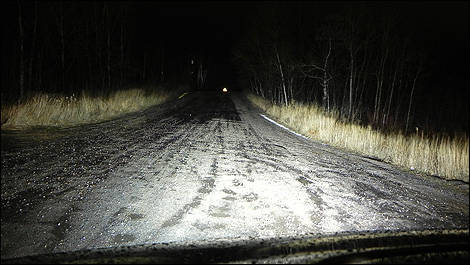Xenon lights are those fancy-looking, often colorful lights you see on high-end cars going down the road. But they’re far from merely cosmetic.
Your writer has tested hundreds of cars over countless thousands of kilometers through a variety of weather across Central and Northern Ontario after dark.
I have a conclusion: xenon lighting is better. Much better. It lets you see more clearly with less strain, it projects light farther up the road, farther to the sides, and makes halogen lighting systems look dull, dim and yellow by comparison.
Halogen headlights work like the incandescent lightbulb you’ll find in a household lamp. An electric current passes through a filament, making it get very hot and lighting it up.
Conversely, xenon lighting works with gas discharge. An arc is generated within a quartz cylinder that contains a mixture of gasses when electricity is passed through it.
Xenon engages reflective surfaces (like signs and cyclist safety-vests) from farther away, too. After a few hours of nighttime driving with xenon illumination, this writer’s eyes prove consistently less tired and worn-out. Yours will, too.
Mercedes-Benz’s David Sherrard explains how xenon headlamps compare to conventional halogen units.
“The key benefits of xenon headlamps versus halogen headlamps include outstanding brightness compared to conventional headlamps, longer service life, significantly improved lighting range and broader illumination of the edges of the road.”
Trouble is, xenon is a relatively new lighting technology that’s only started becoming popular on affordable cars in recent years. But the automotive aftermarket has picked up on the benefits of xenon lighting — and numerous companies offer xenon retrofit kits for shoppers after improved illumination.
Before
After
Your writer has tested hundreds of cars over countless thousands of kilometers through a variety of weather across Central and Northern Ontario after dark.
I have a conclusion: xenon lighting is better. Much better. It lets you see more clearly with less strain, it projects light farther up the road, farther to the sides, and makes halogen lighting systems look dull, dim and yellow by comparison.
Halogen headlights work like the incandescent lightbulb you’ll find in a household lamp. An electric current passes through a filament, making it get very hot and lighting it up.
Conversely, xenon lighting works with gas discharge. An arc is generated within a quartz cylinder that contains a mixture of gasses when electricity is passed through it.
Xenon engages reflective surfaces (like signs and cyclist safety-vests) from farther away, too. After a few hours of nighttime driving with xenon illumination, this writer’s eyes prove consistently less tired and worn-out. Yours will, too.
Mercedes-Benz’s David Sherrard explains how xenon headlamps compare to conventional halogen units.
“The key benefits of xenon headlamps versus halogen headlamps include outstanding brightness compared to conventional headlamps, longer service life, significantly improved lighting range and broader illumination of the edges of the road.”
Trouble is, xenon is a relatively new lighting technology that’s only started becoming popular on affordable cars in recent years. But the automotive aftermarket has picked up on the benefits of xenon lighting — and numerous companies offer xenon retrofit kits for shoppers after improved illumination.
Before
 |
After
 |
| Photo: Justin Pritchard |


